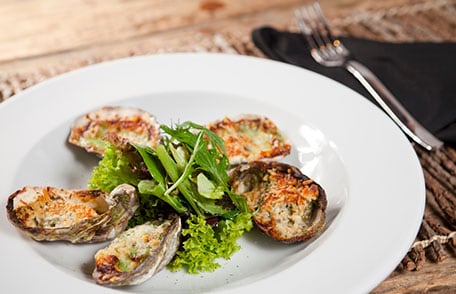Oysters and Vibriosis

Raw oysters can ruin your summer. That’s because you can get very sick from eating raw oysters. Learn about vibriosis, a disease linked to raw oysters – and how to protect your health when it comes to oysters and certain other shellfish.
The days are growing longer and the temperature is rising. For many people, that means it’s the best time to enjoy their favorite seafood: oysters. It is also the time of year that most illnesses from raw oysters occur. Whenever and wherever you like to enjoy oysters, eating raw oysters and certain other undercooked shellfish, such as clams and mussels, can put you at risk for infections.
One of the infections you might get from eating raw oysters is caused by some types of Vibrio, bacteria that occur naturally in coastal waters where oysters live. This bacteria can become concentrated in an oyster’s body because oysters function like a filter: they eat by constantly drawing in water, and materials in the water—including harmful bacteria—are retained within the oyster’s body. When someone eats raw or undercooked oysters that contain bacteria or exposes a wound to seawater that contains Vibrio, he or she can get an illness called vibriosis.
Vibriosis causes about 80,000 illnesses and 100 deaths in the United States every year. Most of these illnesses happen from May through October when water temperatures are warmer. However, you can get sick from eating raw or undercooked oysters during any month of the year, and raw oysters from typically colder waters also can cause vibriosis.
An oyster that contains harmful bacteria doesn’t look, smell, or even taste different from any other oyster. The only way to kill harmful bacteria in oysters is to cook them properly.
What are the symptoms of vibriosis?
Most Vibrio infections from oysters, such as Vibrio parahaemolyticus infection, result in only diarrhea and vomiting. However, people with a Vibrio vulnificus infection can get very sick. As many as 1 in 3 people with a V. vulnificus infectiondie. This is because the infection can result in bloodstream infections, severe blistering skin lesions, and limb amputations. If you develop symptoms of vibriosis, tell your medical provider if you recently ate or handled raw shellfish.
Who is more likely to get vibriosis?
Anyone can get sick from vibriosis, but you may be more likely to get an infection or severe complications if you:
- Have liver disease, alcoholism, cancer, diabetes, HIV, or thalassemia.
- Receive immune-suppressing therapy for the treatment of disease, such as for cancer.
- Have an iron overload disease, such as hemochromatosis.
- Take medicine to lower stomach acid levels, such as Nexium and Pepcid.
- Have had recent stomach surgery.
How do people get vibriosis?
Most people become infected by eating raw or undercooked shellfish, particularly oysters. Some people get infected through an open wound when swimming or wading in brackish or salt water.
How can I stay safe?
Follow these tips to reduce your chances of getting an infection when eating or handling shellfish and other seafood:
- Don’t eat raw or undercooked oysters or other shellfish. Fully cook them before eating, and only order fully cooked oysters at restaurants. Hot sauce and lemon juice don’t kill Vibriobacteria and neither does alcohol.
- Some oysters are treated for safety after they are harvested. This treatment can reduce levels of vibrios in the oyster but it does not remove all harmful germs. People who are more likely to get vibriosis should not eat any raw oysters.
- Separate cooked seafood from raw seafood and its juices to avoid cross contamination.
- Wash your hands with soap and water after handing raw seafood.
- Cover any wounds if they could come into contact with raw seafood or raw seafood juices or with brackish or salt water.
- Wash open wounds and cuts thoroughly with soap and water if they have been exposed to seawater or raw seafood or its juices.






















.jpg)












No hay comentarios:
Publicar un comentario